Achenes ± compressed turbinate, obscurely 2–5-ribbed or strongly 10-ribbed, usually glandular or glutinous, densely long-ascending hispid; disk-floret pappus copious, 2-several-seriate of slender plumose or barbellate setae, the setae all similar increasing in length to the inside, or somewhat dimorphic with the outer setae slender and the inner stouter narrowly scale-like and often ± scarious-winged in the lower part.
Leaves alternate, occasionally subrosulate, sessile and ± stem-clasping occasionally stem-sheathing at the base, usually discolorous, entire or serrulate on the margins or revolute, indumentum as for stems and usually more dense on the leaf lower surface, 3–5-veined from the base or obscurely so.
Capitula homogamous and discoid, all florets hermaphrodite, or capitula heterogamous and disciform (in the Flora Zambesiaca area) with the outer florets neuter, 1-numerous, sessile or shortly stalked, solitary and terminal or spiciform to subpaniculate.
Phyllaries many-seriate, imbricate, appressed or spreading, the outer sometimes squarrose or reflexed, sometimes extending onto the capitulum stalk, the innermost sometimes shorter than the rest, chartaceous to stiffly coriaceous, pungent or subulate.
Disk-floret corollas yellowish to creamy-brown or purplish to whitish, hermaphrodite and regularly deeply 5-lobed, the lobes ± equalling the tube in length, corollas glabrous.
Annual herbs, or suffrutices with annual stems from woody taproots or from woody rootstocks with thong-like roots, or sometimes from semi-woody tuberous rootstocks.
Stems 1-several, erect or decumbent, sometimes caespitose, simple or branching, sericeous-araneose to lanate or glabrescent, occasionally abbreviated or absent.
Ray-florets usually absent, or when present neuter with filiform sub-bilabiate corollas, and a pappus of several-seriate barbellate setae.
Anther apical appendage lorate-lanceolate, thecae bases sagittate produced into long retrorse-ciliate tails.
Style shortly bifid, the branches not separating, tips obtuse with minute sweeping hairs.
Receptacular paleae absent.
